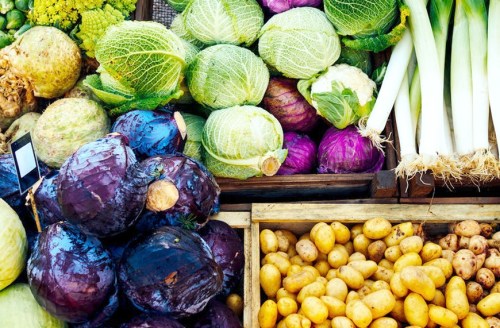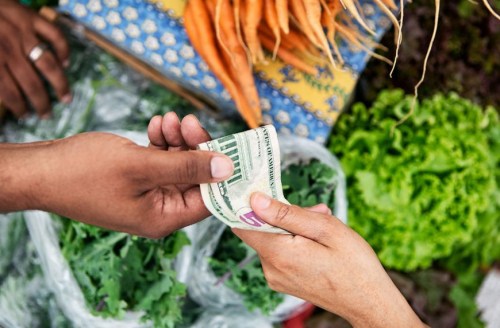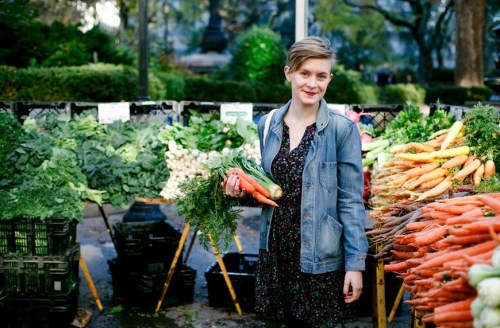Farmers’ markets are, I believe, some of the happiest places on earth. Stepping into one is like taking a trip through time, back to when food was freshly picked and sold by neighbors to neighbors. It seems like the sun is always shining at the market, often illuminating cute couples holding hands as they palm avocados for ripeness. Sometimes, babies are involved. It’s sheer bliss.
Farmers’ markets offer more than just a serotonin boost, however. These eco-friendly marketplaces provide opportunities to interact with your local community, actually meet the people tending to your food, try unfamiliar fruits and vegetables, and even save money. In the process, you’ll also be doing two other meaningful things, says Brie Mazurek, Communications Director for the Center for Urban Education about Sustainable Agriculture (CUESA).
“It’s so important to support local, organic, and sustainable farmers, and there’s no better way to do that then at the farmers’ market because money is going directly to the farmer,” she explains. “Plus, you’re cutting down on food miles, or how far your food is traveling.”
Whatever it is that motivates you to visit the market—your carbon footprint, delicious strawberries, or a potential encounter with your hot neighbor—keep reading for a rundown of everything you need to know to make the most of your visit.
Here’s the ultimate guide to shopping your local farmers’ market.

Organic vs. all-natural: What’s the difference?
In order to label their produce organic, farmers must get government-certified. “There is just one set of standards for organic certification, which is set by the National Organic Program at the USDA,” says Mazurek. “There are then local organizations that are accredited by the USDA, such as CCOF in California, which inspect and hold organic farms and producers accountable to the National Organic Program standards.”
This, however, doesn’t mean every stall without such certification uses pesticides. “Many farmers use organic farming practices, but they may [instead] say ‘no pesticides’ or ‘all-natural,'” says Laura Avery, supervisor of the Santa Monica Farmers Market in Los Angeles.
Mazurek tells me farmers may opt out of organic certification due to the fact that it costs money they’re not able to spend. However, she cautions that claims like “no pesticides” are not regulated in any way, and can therefore be BS. If you don’t see a certified organic sign, she says, your best bet is to ask to the farmer about their practices.
Don’t judge produce by its looks
Here’s the thing: Produce at the farmers’ market is not always pretty. “When you go to the store, apples are all shiny—they usually have some kind of waxy coating on them,” says Linda Mark, who runs a personal shopping business called Farmers Market Fairy. By contrast, the farmers’ market might offer heirloom varieties you wouldn’t see in a store because they’re not as aesthetically perfect or they bruise too easily to be transported long-distance. “You might not want to buy them because they look funny, but those are often really great tasting apples,” she says.
If you’ve been taught to pick produce based on its appearance, this can be a hard habit to break. Mark suggests a simple solution, however. “Go to the market and just try things. It’s not so scary,” she says. Occasionally, farmers will refuse samples on rare commodities such as boysenberries—however, the risk in buying blind is not significant. “You can usually trust your farmer,” she says. “They’re probably not growing things they wouldn’t want to eat themselves.”

What’s in season, when
According to the pros, this really varies based on where you live. In California, for example, moderate temperatures allow markets to stay open year-round. So certain things sold there in the winter will most certainly not be growing in, say, Wisconsin at the same time. Mazurek provides a general guide below, but for more detailed information, you can search seasonality by state using the Seasonal Food Guide website or app.
Spring: Strawberries, asparagus, peas, younger tender greens, some stone fruit (apricots, cherries)
Summer: Tomatoes, some stone fruit (peaches, plums), berries (blackberries, raspberries), summer squash, eggplants, hot peppers (late summer), chard, beets, winter squash (since these store well, they’re often available year-round)
Fall: Winter squash, pumpkins, persimmons, pomegranates, kale, chard, beets, carrots, root vegetables
Winter: Persimmons, pomegranates, greens, chard, kale, winter squash, root vegetables
Yet even if an item is supposed to be in season, it might not always be available due to unfavorable weather conditions, says Mark. Also, if you’re used to shopping in supermarkets, it might surprise you to learn that some ubiquitous produce will not—or should not—ever be sold by a local farmer. Bananas are one example. “You’re not going to find them because they don’t grow in the mainland of the US,” explains Mazurek.
Be aware that not all vendors are legit
Sad but true—some “farmers” fake it. As in, they buy wholesale produce from wherever, and then pass it off as something they’ve grown themselves. Certain states, like California, have enacted legislation aimed at preventing this, but it pays to be discriminating nonetheless.
“There are red flags to watch out for,” says Mazurek. “Produce that’s out of season for your region—like tomatoes or peaches in the middle of winter—can be an obvious one.” Cartons bearing another producer’s name or produce that is waxed or extremely uniform in size and shape might also be indicators that the goods are being resold from another grower, she explains.
That said, there are sometimes logical exceptions to these rules. For instance, says Mazurek, some farmers have hothouses or cold storage that helps extend the season for certain crops, so it’s worth talking to the seller if you have questions. And if it still seems sketch? “If you have concerns that a particular vendor is selling something they didn’t grow, talk to your farmers’ market manager or contact the county agricultural commissioner,” she advises.

Follow the chefs
Another way to suss out the best produce, says Mark, is via social media. Follow chefs or foodies who frequent the market to see what they’re buying. “I call out the farms I’m buying from [on Instagram], and I also try to mention [produce] varieties and which market I’m at,” she says.
When possible, Mark recommends seeking out a “chefs’ market,” which will often feature more interesting produce than other markets. “A farmer will grow something specifically because a chef requested it, and if they’re from a pretty successful restaurant, the farmer can grow a whole crop and it’s guaranteed to sell,” she explains. “Farmers will then sometimes incorporate a little of that for their customers to buy.”
If you don’t know where the chefs in your town shop, Mark suggests looking for a farm-to-table restaurant, where source farms are often printed directly on the menu. “Then you can find out which market that farm goes to, and it’s probably going to be a pretty good market,” she advises.
Don’t be afraid to start a conversation
Not sure what something is, or how to prepare it, or even whether or not it’s ripe? Just ask. “Part of the benefit of interacting directly with the farmer is that they intimately know the product,” says Mazurek.
This is especially valuable if it’s a fruit or veggie you’ve never seen before. “There are some unique things at the farmers’ market that are more complicated, like a veggie called puntarella which takes all kinds of weird steps to prepare,” says Mark. For personalized attention, Mazurek recommends arriving to the market early, before farmers are overwhelmed by clamoring crowds.

To haggle, or not to haggle?
None of my experts were too keen on the question of whether or not you should bargain with farmers, and for good reason. “Before asking why a basket of blackberries costs $5, consider what it must be like to pluck perfectly ripe blackberries one at a time into small baskets for hours a day in the hot sun,” says Avery, who adds that farmers sell their produce at the price it costs to raise it.
There are ways to save, however. “You can get quantity discounts if you buy several pounds of an item, or look for ‘canning grade’ or ‘visually distressed’ fruit for deeper discounts,” Avery says. Mazurek also recommends comparison shopping around the market before buying, as different farmers will offer different prices. Some markets, she adds, take EBT (a form of food stamps) or have other grant programs in place for those with especially limited financial resources.
As for how to pay, Mazurek says markets’ cash-only rep is outdated, and that many vendors now take cards. However, if you are going to pay in cash, you’ll want to bring small bills. “Especially first thing in the morning,” Avery advises.
How to stretch the season
If you’re obsessed with a certain fruit or vegetable, buying in-season via farmers’ markets can sometimes be a bummer—it means that some types of produce may make only a limited appearance on your table. However, Mark says there are ways to extend the shelf lives of your favorite seasonal hauls.
For example, she has a client who asks her to buy “hundreds of pounds” of tomatoes when they’re in season. The client then cans them for use throughout the year in tomato sauce. You, too, can buy in bulk in this way in order to enjoy local produce, no matter the season. Get started with these easy canning tricks —mmm, honeyed apricots.
Need a place to put your farmers’ market haul? Try tucking your veggies into these Whole30 recipes. Or, blend them up—here’s how to create an efficient smoothie bar at home.
Sign Up for Our Daily Newsletter
Get all the latest in wellness, trends, food, fitness, beauty, and more delivered right to your inbox.
Got it, you've been added to our email list.











